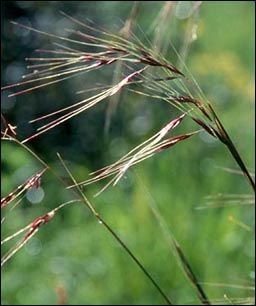
Throughout California, native grasses have been, for the most part, replaced by exotic and frequently destructive grasses. Purple Needle Grass is a native grass that historically was found in grasslands, chaparral and oak woodlands from southern Baja to northern California. Where it once covered over 20 million acres, it is currently found on only about 100,000 acres. However, there is now a growing demand for it in restoration activities and the reseeding of burned areas. Purple Needle Grass grows in a variety of soil types, such as dry, clay soils and well-drained, rich soils.
Native grasses are very drought tolerant, limit erosion, and live for periods of over a century or more. Purple Needle Grass can also control nuisance weeds, and hence reduce the cost of labor and chemicals for that purpose. It can also help displace the very invasive yellow star thistle.
Purple Needle Grass has roots of up to sixteen feet long. These roots hold moisture, that not only sustains the plant in times of drought, but makes the plant slow to burn. Most of the leaves of the plant stay green during the year. Native herbivores use the leaves and roots as food.
While Purple Needle Grass is not suitable as a lawn grass because of the clumping nature of its growth, it can be used as a decorative grass.
Nasella pulchra is the botanical name of the plant. The Latin words “pulchra” and “nassa” mean beautiful and basket with a narrow neck, respectively.
The top and lower right photos were taken at Sedgwick Reserve on March 22, 2003.
The lower left is a close-up of Purple Needle Grass growing on More Mesa.
References:
Support Nassella pulchra
 |
 |